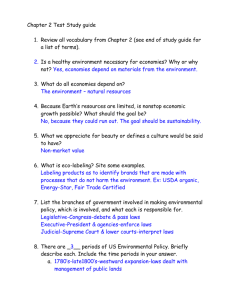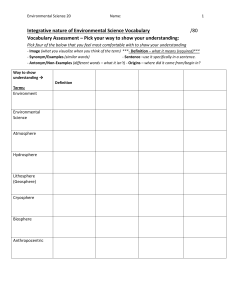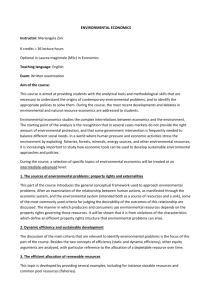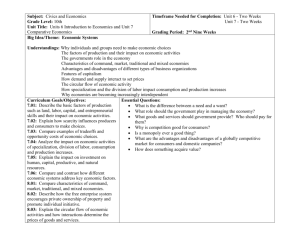Unit 2 Power point
advertisement
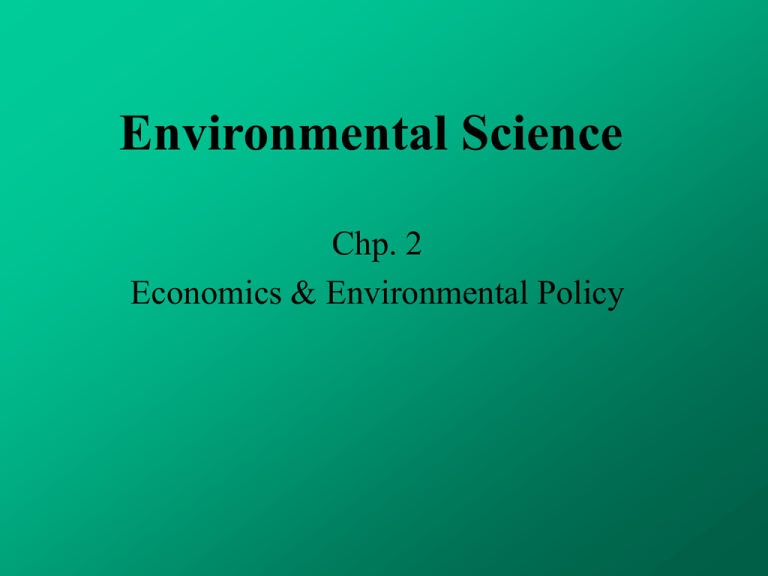
Environmental Science Chp. 2 Economics & Environmental Policy Chp. 2 vocabulary terms (16) • • • • • • • • • • Economics Supply Demand Cost-benefit analysis Ecological economics Environmental economics Non-market value Ecolabeling Policy Environmental policy • Environmental Impact Statement (EIS) • Command-and-control approach • Subsidy • Green tax • Cap-and-trade • Lobbying What is Economics? • • The study of how resources are converted into goods & services, and how they are distributed and used. 3 types of economies: 1. Centrally planned economy: government decides – Ex: Socialist & communist countries 2. Free market economy: individuals decide 3. Mixed economy: both gov’t & individuals decide – Almost all modern economies Supply & Demand • Supply: how much of a product is offered for sale at a given price • Demand: how much of a product people will buy at a given price if free to do so • Sellers want to sell the most at the highest price • When demand is LOW: seller may drop price and slow production • When demand is HIGH: seller may raise price and increase production • Equilibrium: amount produced = demand Supply & Demand Curve Cost-Benefit Analysis • A method used to compare what they will sacrifice and gain by a specific action • If benefits outweigh costs, the action is usually pursued • Not all costs & benefits can be easily identified, so the analysis can be complicated and controversial • You can use the Decision-Making Model you were taught in Unit 1 for this. Economics & the Environment • All economies depend on the environment for resources & management of wastes • Think of natural resources as the “goods” produced by nature • Ecosystem services are provided that purify air & water, recycle nutrients, and contain wastes. • When economic activity depletes or pollutes the “goods,” economic activity is affected. • Ex. Vacation destination’s sewage system can no longer keep up with wastes. Result: polluted water, swimming areas closed, tourists stop coming & local businesses suffer. • Traditionally, many environmental factors such as beautiful views, fresh air, & clean water don’t have a monetary value assigned to them, therefore they are not always considered in the Cost-benefit Analysis. When considering the impact on the environment, look at: • Internal Costs & Benefits: only affect buyers & sellers directly. – External costs & benefits involve parties other than the buyers & sellers • Short-term Effects: usually given more weight than long-term effects, such as resource depletion. • Endless Resources: economists often do not consider that resources can run out or be overused. • Growth: economists assume that continued economic growth is required to keep employment high and maintain social order. Sustainability??? Economics & Sustainability • Ecological economics apply the principles of the Earth’s systems to economics, advocating economies that remain stable & sustainable • Environmental economics contend economies are unsustainable if resource use is not made more efficient, but can be sustainable if environmental challenges are addressed. • Both trends in economics recognize that suppliers of goods & services need to consider how to conserve resources and reduce harm to the environment. We Need to Assign Market Values • Services provided by our ecosystems have non-market values (aesthetic value, cultural value, scientific value, educational value) • Because they lack a specific $ value, they can become exploited. • Surveys are often used to ask people to estimate how much they would pay for these. • Comparisons are also used. Ex.- prices of similar homes, some overlook a woodlot v.s. some that do not have a “green” view. Market Failure • Market failure occurs when markets don’t consider the environment’s positive effects on economies or reflect the negative effects of that economic activity on the ecosystem. • To counteract, governments can give economic incentives to conserve resources or reduce pollution, or they can penalize with taxes & fines for not doing so. Changing Consumer Values • Ecolabeling: labels that show how the products were grown, harvested or manufactured, telling consumers which brands do not harm the environment. • Encourages businesses to a more sustainable process when consumer choose ecolabeled products. Small Group Activity • Refer to “Cleaning the Tides of San Diego and Tijuana” on page 35 of your textbook. • Apply the Decision-Making Model we learned in Unit 1 to the following question: • How can we best balance our own interests and needs with the health of the environment? What is Environmental Policy??? • Policy: formal set of generalized plans to address problems & guide decision-making • Environmental policy: policy that addresses interactions between humans and the environment. • It’s goal should be to protect environmental quality, protect natural resources, and ensure equity. • When government is making environmental policies, it interacts with citizens, organizations, and businesses. • There also must be input from science, ethics, and economics. • The U.S.A. has been a pioneer in this area, involving all 3 branches of government. • Legislative branch: a policy enters as a proposed law. If both houses pass the bill, it moves to…. • Executive branch: legislation is either approved or vetoed by the President, becoming law and assigned an agency to enact/enforce it. • Judicial branch: lawsuits are tools to ensure compliance with the law. The courts also hear complaints if laws are infringing on rights of citizens and businesses. State and Local Policy • Environmental policy is also created at the state and local levels, which mirror the federal. • State laws canNOT violate US Constitution. • Environmental policy strength varies area to area. It becomes more of a priority in cities that have dealt with issues & messy cleanups. • California, New York & Massachusetts have strong environmental laws and wellfunded agencies. History of U.S. Environmental Policy The 1st Period (1780s to late 1800s) • Mostly laws dealing with public land management and westward expansion. • Public perception was that lands and natural resources in the West were endless. • Westward expansion relieved crowded conditions in eastern cities, but displaced Native Americans. The 2nd Period (late 1800s – 1900s) • Public perception & government policy toward natural resources began to shift, realizing they could be used up. • Forest Reserve Act of 1891 • Soil Conservation Acts of 1930s • Wilderness Act of 1964 • Reduced environmental problems associated with westward expansion • Policies led to the national forest system, refuge system and park system. The 3rd Period (mid-to late-1900s) • U.S. was more densely populated and driven by technology, heavy industry, & intensive resource consumption. • Silent Spring by Rachel Carson • Fires on the oil-polluted Cuyahoga River • National Environmental Policy Act (1969) • Earth Day (1970) Modern U.S. Environmental Policy • We’ve learned from the past, regulating pesticides more, and cleaner air & water. • Annual Earth Day celebrations • National Environmental Policy Act (NEPA) • Formation of Environmental Protection Agency (EPA) • Marine Mammal Protection Act • Endangered Species Act • Clean Air Act • Pollution Prevention Act National Environmental Policy Act • January 1, 1970 President Nixon signed NEPA into law • Created an agency: Council on Environmental Quality • Environmental Impact Statement requires gov’t agencies & businesses to evaluate the impact of project on the environment before proceeding. • EISs involve citizens in the policy process Environmental Protection Agency • President Nixon called for a new approach based on understanding environmental problems are interrelated • Now a single major entity would oversee tasks (EPA) • EPA is responsible for conducting/evaluating research, monitoring environmental quality, and setting & enforcing standards for pollution levels, as well as educating the public. Post-1980 • Backlash – many felt some laws imposed too great an economic burden on businesses and individuals. • Global warming and climate change are becoming more evident • New era focused on cleaning up toxic chemicals and sustainability • Obama administration is focusing on conserving energy, developing renewable energy technologies, and reducing carbon emissions. Small Group Activity • Discuss the advantages & disadvantages that come with an international effort to protect the environment. 1. Why is an international approach to pollution reduction sensible? 2. What barriers might keep governments from working together to form environmental policies? International Environmental Policy • Solving Environmental problems worldwide requires creativity and cooperation among nations. • Environmental problems are not restricted by borders, so international laws are needed to solve issues among nations (trans-boundary problems). • Rivers are often shared by many nations • Air pollutants travel on wind currents • Animals migrate • Multinational corporations The United Nations (U.N.) • Formed in 1945, headquartered in NYC • Currently 190 nations are members • Purpose: promote peace and to help solve economic, social, cultural & humanitarian problems. • UN has helped shape international environmental policies. • Does not have the power to enforce laws, but they can influence behavior of nations (funding, peer pressure, media,…) The European Union (EU) • Formed after World War II • Currently has 27 member nations • Goal: promoting Europe’s economic and social progress • EU can sign treaties and enact regulations that have the same authority as national laws in each member nation • EU’s European Environment Agency produces current environmental data and analyses to help guide policymakers World Trade Organization (WTO) • Established in 1995 • Promotes free trade & enforces fair trade practices among its member nations. • WTO has the authority to impose fines on nations that do not comply • Criticism: some feel WTO often adds to the environmental problems (ex. – EPA regulations on burning gasoline discriminated against some international petroleum companies according to WTO World Bank • Established in 1944 • Owned by 186 member nations • Provides interest-free credits, lowinterest loans, or grants to poor nations for projects that improve standard of living • Shapes environmental policy by funding projects • Criticism: it sometimes funds projects that are not sustainable Non-Government Organizations • Environmental organizations that are not affiliated with governments • Influence international policy through research, lobbying, education, and protest • Ex. – Greenpeace, Population Connection, Conservation International • Contribute considerable funding, expertise and research which helps solve environmental problems Command-and-Control Approach • Approach that helps governments set rules & threaten punishment for violations • In U.S., most policies are legislation from Congress and regulations from administrative agencies. • Many successes: cleaner air & water, safer workplaces, healthier ecosystems. • Sometimes well meaning actions lead to unexpected circumstances • Incentives: tax breaks & subsidies Tax Breaks and Subsidies • Subsidy: giveaway of cash or public resources to encourage an activity or lower the price of a product. • Green taxes: imposed on companies whose activities are harmful to the environment (widely used in Europe) • Both are incentives to reduce pollution while allowing the company to decide how best to do it. Cap-and-Trade • Governments determine the overall amount of pollution it will accept for a specific pollutant and issues permits that allow polluters to emit a certain %. • Permits can be bought, sold & traded among companies, utilities, industries • Allows owner to make $, meet the needs of factories, and not increase pollution • Problem: trading can concentrate area of pollution with buying extra permits Local Incentives • Waste disposal charged by how much is used • Rebates given to residents for waterefficient toilets/appliances • Market-based incentives can reduce environmental impact, industry costs, and concerns about gov’t regulations. • More complicated than command-andcontrol approaches, but lessen environmental impact at a lower overall cost. Environmental Policy Process 1. Identify the Problem 2. Identify the Causes – Often requires scientific research 3. Envision a Solution – Involves scientific, social & political ideas 4. Get Organized – Get the attention of elected officials 5. Gain Access – Lobbying can influence elected officials 6. Help a Solution become Policy – Draft a bill, legislator introduces it, law? Getting Involved!!! • Policy process is long & difficult, but it yields effective results across the nation • Many environmental policies began as movements in small towns inspired by one person or a small group of people. • Young people can make an impact. • Join an environmental group. • Use social media responsibly. • You can make a difference!!!! Homework • Study for your Jeopardy test review as if you are taking the test tomorrow!!! • Chapter Review pages 58-59 in your textbook
